I.Técnica de relleno con cemento óseo
El método de relleno con cemento óseo es adecuado para pacientes con defectos óseos AORI tipo I más pequeños y actividades menos activas.
La tecnología simple de cemento óseo requiere técnicamente una limpieza exhaustiva del defecto óseo, y el cemento óseo rellena el defecto óseo durante la etapa de masa, de modo que se puede rellenar en los espacios en las esquinas del defecto tanto como sea posible, logrando así un ajuste perfecto con la interfaz del hueso huésped.
El método específico deBunoCmento +SLa tecnología de la tripulación consiste en limpiar a fondo el defecto óseo, fijar el tornillo en el hueso receptor y tener cuidado de que la tapa del tornillo no sobrepase la superficie ósea de la plataforma articular después de la osteotomía. A continuación, mezclar el cemento óseo, rellenar el defecto óseo en la fase de masa y envolver el tornillo. Ritter MA et al. utilizaron este método para reconstruir el defecto óseo de la meseta tibial, alcanzando un grosor de 9 mm y sin aflojamiento 3 años después de la operación. La tecnología de relleno con cemento óseo elimina menos hueso y, posteriormente, utiliza la revisión de prótesis convencional, lo que reduce los costos del tratamiento gracias al uso de prótesis de revisión, lo cual tiene un valor práctico.
El método específico de la tecnología de cemento óseo + tornillo consiste en limpiar a fondo el defecto óseo, fijar el tornillo al hueso receptor y asegurar que el tapón del tornillo no sobrepase la superficie ósea de la plataforma articular después de la osteotomía. Posteriormente, mezclar el cemento óseo, rellenar el defecto óseo en la fase de masa y envolver el tornillo. Ritter MA et al. utilizaron este método para reconstruir el defecto óseo de la meseta tibial, alcanzando un grosor de 9 mm y sin aflojamiento 3 años después de la cirugía. La tecnología de relleno con cemento óseo elimina menos hueso y, posteriormente, utiliza la revisión de prótesis convencional, lo que reduce el coste del tratamiento gracias al uso de prótesis de revisión, lo cual tiene un valor práctico (Figura).I-1).
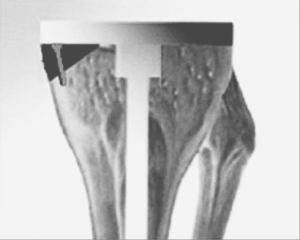
CifraI-1Relleno de cemento óseo y refuerzo con tornillos
II.Técnicas de injerto óseo
El injerto óseo por compresión se puede utilizar para reparar defectos óseos, tanto inclusivos como no inclusivos, en la cirugía de revisión de rodilla. Es especialmente adecuado para la reconstrucción de defectos óseos de tipo AROI I a III. En la cirugía de revisión, dado que la extensión y el grado de los defectos óseos suelen ser graves, la cantidad de hueso autólogo obtenido es pequeña y, en su mayoría, hueso esclerótico cuando se retiran la prótesis y el cemento óseo durante la cirugía para preservar la masa ósea. Por lo tanto, el hueso alogénico granular se utiliza a menudo para el injerto óseo por compresión durante la cirugía de revisión.
Las ventajas del injerto óseo por compresión son: conservar la masa ósea del hueso huésped; reparar defectos óseos grandes, simples o complejos.
Las desventajas de esta tecnología son: la operación requiere mucho tiempo, la tecnología de reconstrucción es exigente (especialmente cuando se utilizan jaulas MESH grandes) y existe un potencial de transmisión de enfermedades.
Injerto óseo de compresión simple:El injerto óseo por compresión simple se utiliza a menudo para defectos óseos inclusivos. La diferencia entre el injerto óseo por compresión y el injerto óseo estructural radica en que el material granular del injerto óseo por compresión puede revascularizarse rápida y completamente.
Jaula metálica de malla + injerto óseo de compresión:Los defectos óseos no inclusivos suelen requerir reconstrucción con jaulas metálicas de malla para implantar hueso esponjoso. La reconstrucción del fémur suele ser más difícil que la de la tibia. Las radiografías muestran que la integración ósea y la conformación ósea del material de injerto se completan gradualmente (Figura).II-1-1, CifraII-1-2).
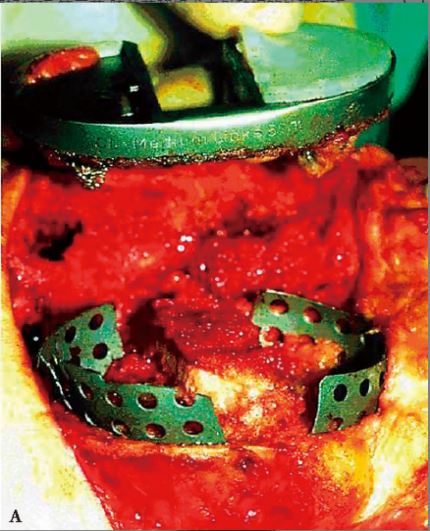
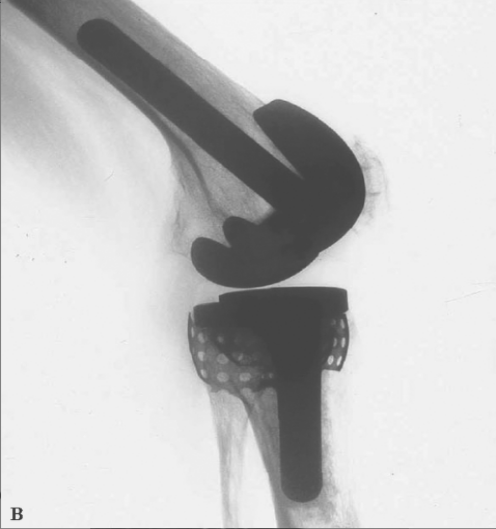
CifraII-1-1Injerto óseo de compresión interna con jaula de malla para reparar el defecto óseo tibial. A. Intraoperatoria; B. Radiografía postoperatoria.
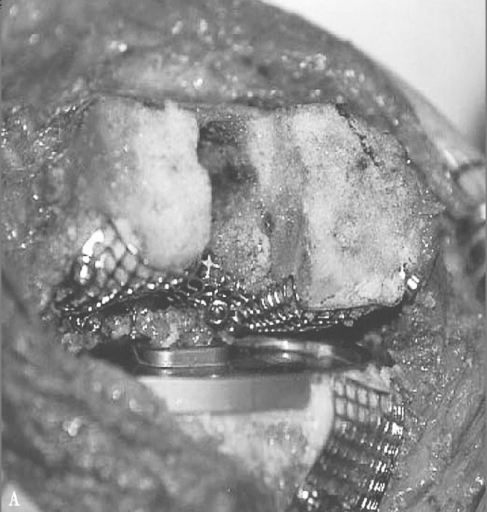
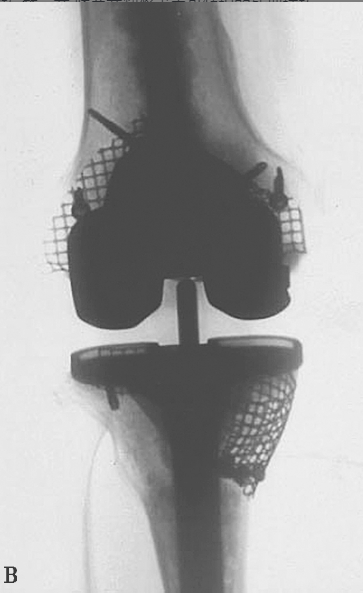
Figuray II-1-2Reparación de defectos óseos femorales y tibiales con injerto óseo de compresión interna con malla de titanio. A. Intraoperatoria; B. Radiografía postoperatoria.
Durante la artroplastia de revisión de rodilla, el hueso estructural alogénico se utiliza principalmente para reconstruir defectos óseos tipo II o III de AORI. Además de contar con excelentes habilidades quirúrgicas y amplia experiencia en reemplazos complejos de rodilla, el cirujano también debe elaborar planes preoperatorios minuciosos y detallados. El injerto óseo estructural puede utilizarse para reparar defectos óseos corticales y aumentar la masa ósea.
Las ventajas de esta tecnología incluyen: se puede fabricar en cualquier tamaño y forma para adaptarse a defectos óseos de diferentes formas geométricas, tiene un buen efecto de soporte en las prótesis de revisión y se puede lograr una integración biológica a largo plazo entre el hueso alogénico y el hueso huésped.
Las desventajas incluyen: tiempo quirúrgico prolongado al cortar hueso alogénico; fuentes limitadas de hueso alogénico; riesgo de pseudoartrosis y retraso en la unión debido a factores como la reabsorción ósea y la fractura por fatiga antes de que se complete el proceso de integración ósea; problemas con la absorción e infección de los materiales trasplantados; potencial de transmisión de enfermedades; y estabilidad inicial insuficiente del hueso alogénico. El hueso estructural alogénico se obtiene del fémur distal, la tibia proximal o la cabeza femoral. Si el material de trasplante es grande, generalmente no se produce una revascularización completa. Las cabezas femorales alogénicas se pueden utilizar para reparar defectos óseos del cóndilo femoral y la meseta tibial, principalmente para la reparación de grandes defectos óseos de tipo cavidad, y se fijan mediante ajuste a presión después del recorte y la conformación. Los primeros resultados clínicos del uso de hueso estructural alogénico para reparar defectos óseos mostraron una alta tasa de curación del hueso trasplantado (FiguraII-1-3, CifraII-1-4).
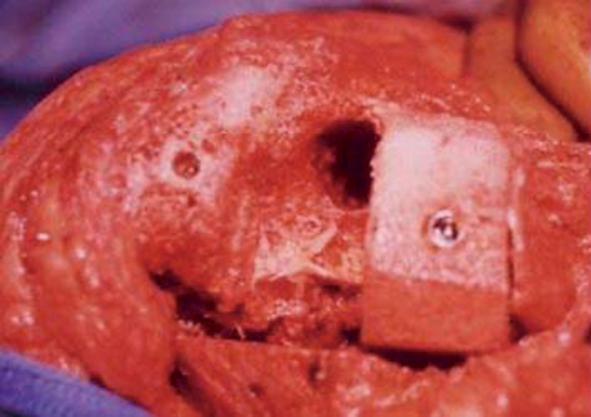
CifraII-1-3Reparación de defecto óseo femoral con injerto óseo alogénico de estructura de cabeza femoral
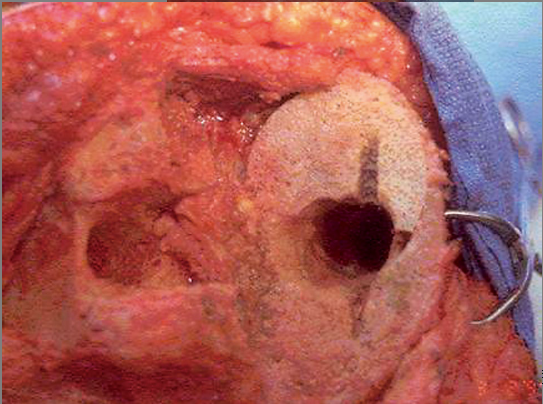
CifraII-1-4Reparación de defecto óseo tibial con injerto óseo de cabeza femoral alogénico
III.Tecnología de relleno de metal
Tecnología modular. La tecnología modular permite ensamblar rellenos metálicos con prótesis y vástagos intramedulares. Los rellenos incluyen diversos modelos para facilitar la reconstrucción de defectos óseos de diferentes tamaños.
Metálico Protésico Aumentos:El espaciador metálico modular es principalmente adecuado para defectos óseos sin contención AORI tipo II con un espesor de hasta 2 cm.El uso de componentes metálicos para reparar defectos óseos es conveniente, simple y tiene efectos clínicos confiables.
Los espaciadores metálicos pueden ser porosos o sólidos, y sus formas incluyen cuñas o bloques. Los espaciadores metálicos pueden conectarse a la prótesis articular mediante tornillos o fijarse con cemento óseo. Algunos investigadores creen que la fijación con cemento óseo puede evitar el desgaste entre los metales y recomiendan la fijación con cemento óseo. Algunos investigadores también abogan por el método de usar primero cemento óseo y luego reforzar con tornillos entre el espaciador y la prótesis. Los defectos femorales a menudo ocurren en las partes posterior y distal del cóndilo femoral, por lo que los espaciadores metálicos generalmente se colocan en las partes posterior y distal del cóndilo femoral. Para los defectos óseos tibiales, se pueden seleccionar cuñas o bloques para la reconstrucción para adaptarse a diferentes formas de defectos. La literatura informa que las tasas de excelente y bueno son tan altas como 84% a 98%.
Los bloques en forma de cuña se utilizan cuando el defecto óseo es cuneiforme, lo que permite preservar más hueso huésped. Este método requiere una osteotomía precisa para que la superficie de la osteotomía coincida con el bloque. Además de la tensión de compresión, también existe una fuerza de cizallamiento entre las interfaces de contacto. Por lo tanto, el ángulo de la cuña no debe superar los 15°. En comparación con los bloques en forma de cuña, los bloques metálicos cilíndricos presentan la desventaja de aumentar la extensión de la osteotomía, pero la operación quirúrgica es cómoda y sencilla, y el efecto mecánico es casi normal.III-1-1A, B).
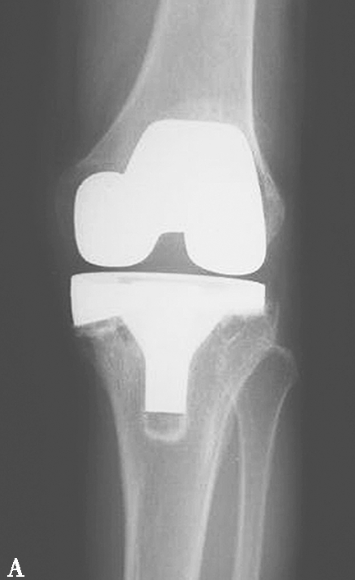
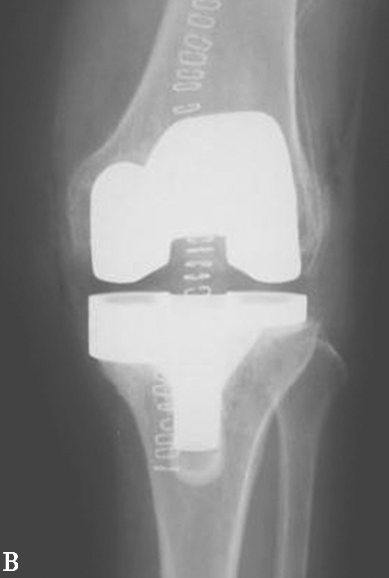
CifraIII-1-1Espaciadores metálicos: Un espaciador en forma de cuña para reparar defectos tibiales; B espaciador en forma de columna para reparar defectos tibiales
Dado que los espaciadores metálicos están diseñados en diversas formas y tamaños, se utilizan ampliamente en defectos óseos no contenidos y defectos óseos de diversas formas, y proporcionan una buena estabilidad mecánica inicial. Sin embargo, estudios a largo plazo han demostrado que los espaciadores metálicos fallan debido a la protección contra la tensión. En comparación con los injertos óseos, si los espaciadores metálicos fallan y requieren revisión, causarán defectos óseos más grandes.
Hora de publicación: 28 de octubre de 2024










